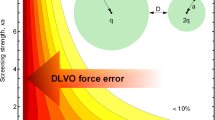Abstract
A simple model for the study of London dispersion interactions is introduced: two spherical boxes, uniformly charged on their surfaces and each containing a freely moving charged particle. The model, also denominated as “interacting quantum balls” model, is applied to calculate the first three dispersion coefficients involving the ground and several excited s states, where dispersion interactions are the only contribution to the interaction energy. Already the first excited symmetric \((1s{-}2s)_+\) state has a negative \(C_6\) dispersion coefficient, corresponding to long range repulsion. In general, a drastic state variation of the dispersion coefficients is observed, depending on the occurence of near-resonance excitation/disexcitation coupling.





Similar content being viewed by others
Notes
Note a typographical error in Ref. [4]: the square root sign is missing.
Note a typographical error in Ref. [4]: the square root sign is missing.
References
Davydov AS (1976) Quantum mechanics. In: International series of monographs in natural philosophy, 2nd Edn. vol 1. Pergamon Press, Oxford, pp 145–146
Brink DM, Satchler GR (1993) Angular momentum. Oxford University Press, Oxford, pp 145–146
Abramowitz M, Stegun IA (1965) Handbook of mathematical functions. Dover, New York, pp 435–441
Thompson DC, Alavi A (2002) Two interacting electrons in a spherical box: an exact diagonalization study. Phys Rev B 66:235118
Thompson DC, Alavi A (2002) Two interacting electrons in a spherical box: an exact diagonalization study. Phys Rev B 66:039901 (Erratum)
Jung J, Alvarellos JE (2003) Two interacting electrons confined within a sphere: an accurate solution. J Chem Phys 118:10825–10834
Jung J, Alvarellos JE (2004) Three, four and five interacting electrons in a spherical box: an exact diagonlization study extended. J Phys Cond Matter 16:7979–7994
Loos P-F, Gill PMW (2010) Correlation energy of two electrons in a ball. J Chem Phys 132:234111
Griffiths DJ (1981) Introduction to electrodynamics. Prentice-Hall, Englewood Cliffs, pp 75–76
Stone A (2013) The theory of intermolecular forces. 2nd Edn. Oxford University Press, Oxford, pp 47–52, 55–73, 64–73
Hirschfelder JO (1967) Perturbation theory for exchange forces, I. Chem Phys Lett 1:325–329
Marinescu M, Dalgarno A (1995) Dispersion forces and long-range electronic transition dipole moments of alkali-metal dimers in excited states. Phys Rav A 52:311–328
Yan Z-C, Babb JF, Dalgarno A, Drake GWF (1996) Variational calculations of dispersion coefficients for interactions among H, He, and Li atoms. Phys Rev A 68:441–451
Zhang J-Y, Mitroy J, Bromley MWJ (2007) Dispersion coefficients of the excited states of lithium atoms. Phys Rev A 75:042509
Herdan R, Hughes TP (1961) New values of the square of the radial integral associated with the dipole matrix elements for transitions in hydrogen-like atoms. Astrophys J 133:294
Ángyán JG (2007) On the exchange-hole model of London dispersion forces. J Chem Phys 127:024108
Heßelmann A (2009) Derivation of the dispersion energy as an explicit density- and exchange-hole functional. J Chem Phys 130:084104
Watson GN (1966) A treatise on the theory of Bessel functions, 2nd edn. Cambridge University Press, Cambridge, pp 133–135
Acknowledgements
Supported through the Deutsche Forschungsgemeinschaft (DFG) within the priority program SPP 1807 “Control of London Dispersion Interactions im Molecular Chemistry” (Grant JA954/4-1). In memoriam Janos G. Ángyán, a wonderful friend and inspiring scientist.
Author information
Authors and Affiliations
Corresponding author
Additional information
Published as part of the special collection of articles In Memoriam of János Ángyán.
Appendix: Matrix elements involving radial functions
Appendix: Matrix elements involving radial functions
As most of the required integrals involving the radial functions \(R_{nl}(r)\) do not appear to be standard knowledge, they will be derived in the following. Though the normalization factor is knownFootnote 2 [4] for the sake of completeness its derivation will also be given.
Proceeding along the lines of the computation of Lommel’s integrals involving products of cylindrical Bessel functions [18] multiplication of the differential equation
with \(j_l(k'r)\) and subtraction by a corresponding product with reversed roles of \(j_l(kr)\) and \(j_l(k'r)\) yields
Partial integration leads to the identity
where \(j'_l(z) = \frac{\mathrm {d} j_l(z) }{{\mathrm {d}} z}\). From this follows orthogonality of the spherical Bessel functions if \(ka = z_{nl}\) and \(k'a = z_{n'l}\) are different zeros of the spherical Bessel function \(j_l(z)\). On the other hand, if \(j_l(ka) = 0\) one also gets
where the rule of l’Hospital has been used in the last equation. From \(j'_l(z) = \frac{l}{z} j_l(z) - j_{l+1}(z)\) [3] one finally obtains the normalization factor \(N_{nl}\) as given after Eq. (2).
Noting that the last recursion formula may also be written as \(r j_{l+1}(kr) = \left( \frac{l}{k} - \frac{\mathrm {d}}{\mathrm {d} k}\right) j_l(kr)\) one obtains
which, employing (28) along with \(j_l(ka) = 0\) and appropriate recursion relations, results in
Taking normalization factors into account, from this one arrives at
Similarly the remaining integrals needed for the \(C_8^{nn',\pm }\) and \(C_{10}^{nn',\pm }\) coefficients can be computed as
and
Rights and permissions
About this article
Cite this article
Jansen, G. Spherical box model for London dispersion interactions. Theor Chem Acc 137, 171 (2018). https://doi.org/10.1007/s00214-018-2374-1
Received:
Accepted:
Published:
DOI: https://doi.org/10.1007/s00214-018-2374-1




